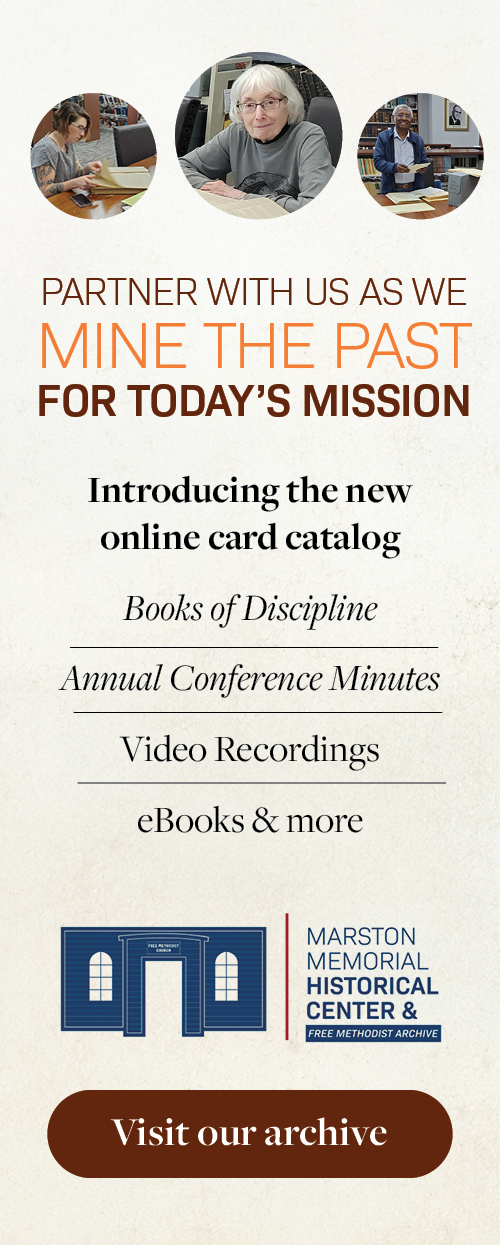
Paul Sunderland
Paul Sunderland, D.W.S., is the music department chair and an assistant professor of music at Greenville University in Greenville, Illinois. He is also the worship arts director at Greenville Free Methodist Church. Sunderland has a doctorate in worship studies from the Robert E. Webber Institute for Worship Studies in Jacksonville, Florida. Paul and his wife, Terri, have two sons, Will and Kyle, who are both Greenville alumni.
Traditional and Contemporary Worship: A Renewed Perspective
By Paul Sunderland
The Free Methodist bishops’ Vision Frame calls us to “show up dependent” with “an observable passion for God’s presence when our congregation gathers.”
A few years ago, Greenville Free Methodist Church changed our Sunday worship schedule from two services to one combined worship service for a summer series. Our staff knew that combining our traditional and contemporary worship services would create some unique challenges, so the staff asked me (the worship arts director) to share a series of five-minute teachings on some common polarizing views of worship. Attempting to use the power of humor in such a situation, I decided to call the series, “Awkward moments with Paul!”
_
“A different perspective may help us realize that we all actually need aspects of both traditional and contemporary worship.”
_
Let me share some thoughts from one of those short sessions on the issue of traditional and contemporary worship, often (yet sadly) referred to as the “worship wars.” I would like to suggest that a different perspective may help us realize that we all actually need aspects of both traditional and contemporary worship.
Bring Across
To begin with, the word “traditional” comes from the Latin traduco, which means to bring across or to pass along. In this sense, traditional is less about something old or practiced for a long time, and more about passing along our essential values to others — especially younger generations. Deuteronomy 6 illustrates such an understanding of tradition, urging us to teach and pass along the core values of worship and faith to our children and our children’s children. This view of traditional is far more about retention than resistance to change. Let me share a story to illustrate:
Years ago, I served as the worship leader in a church where I developed a friendship with a young man named John. John had mental disabilities and the basic maturity of a 5-year-old. John was the life of the party and brought joy to people wherever he went. Early on, I discovered that one of John’s favorite things in life was candy. I developed a habit of putting a few pieces of candy in my pocket every Sunday morning to offer to John as I welcomed him to church. Each week we had a beautiful exchange that went something like this: “John, it’s so good to see you today. Would you like a piece of candy?” John would burst out with a childlike squeal while I removed the wrapper for him. He would pop the candy into his mouth, swallow it whole and shout, “Thank you!” Everyone nearby that witnessed this exchange grinned as we saw the delight on John’s face. In that moment, we all knew that John felt loved and welcomed.
_
“We all need traditional aspects of worship — not merely old ways of doing things, but transformative practices that we are convinced would help all generations of people become more like Christ.”
_
Now I want to suggest that faithfully doing this candy-exchange ritual for well over a decade did not make it a tradition. It only became a tradition when we found out that our family was moving, and I asked someone to continue this important practice of making sure John felt welcome in church. John taught me the value of hospitality in worship, and I was convicted to share this learned priority with someone else. We all need traditional aspects of worship — not merely old ways of doing things, but transformative practices that we are convinced would help all generations of people become more like Christ.
On the other hand, “contemporary” implies “with the times.” Far too often, we assume contemporary means embracing the newest trend. This falls short of an understanding that involves doing things in a way that is fitting and relevant to a particular culture or context of people. 1 Chronicles 12:32 demonstrates the idea of contemporary as being engaged and discerning when the men of Issachar “understood the times and knew what Israel should do.”
While we quickly refer to our choice of musical instruments as an example of “contemporary worship,” don’t underestimate such things as good visual media in our worship services or effective social media as part of our intentional effort to be “with the times.”
Far too many churches have given into the pressure of making contemporary worship primarily about trying to keep up with the newest worship music, rather than knowing their congregation and selecting songs accordingly. Ironically, this leads to a consumeristic “McWorship” form of liturgy, which looks and sounds just like every other trend-chasing church. Ultimately, we lose the art of making good song choices for the people we are privileged to lead when we focus too much on “trendy” worship songs that work somewhere besides our local church setting. On the other hand, when we are committed to relevant, localized worship, we embrace what is unique to our own faith family and make song choices accordingly.
Rooted and Relevant
With a renewed understanding, we begin to see that traditional hymns are not exclusively for older adults, and contemporary songs are not simply for younger people in our churches. Good, vibrant traditional and contemporary songs help us to become a thriving, rooted-and-relevant worship community.
_
“The opposite of traditional means to be disconnected from principles and values developed by previous mentors of the faith.”
_
Our renewed understanding can also help us to realize that the opposite of traditional is not contemporary; the opposite of traditional means to be disconnected from principles and values developed by previous mentors of the faith. Further, the opposite of contemporary is not traditional; the opposite of contemporary is to be irrelevant, not caring about the people who currently attend and those who may soon attend our church. Healthy congregations long to be connected to previous generations (traditional) as well as culturally relevant (contemporary) through their choice of worship songs and other liturgies.
Cherishing and Welcoming
Maybe it’s time that we name the reality that there are healthy and unhealthy aspects of both “traditional” and “contemporary” worship. I wonder if we have the courage to stop playing into the divisive “worship war” debate in order to give our attention to discerning and humbly welcoming a new resource (song) “from the other side”?
I long to see more and more of our churches learn to cherish great traditional songs and liturgies passed along from previous generations, while also welcoming some healthy contemporary songs and practices that keep our worship relevant and relational. Isn’t it time to have some conversations in our churches about how traditional and contemporary worship sources might build and connect us rather than continue to limit and divide us?
+

Paul Sunderland
Paul Sunderland, D.W.S., is the music department chair and an assistant professor of music at Greenville University in Greenville, Illinois. He is also the worship arts director at Greenville Free Methodist Church. Sunderland has a doctorate in worship studies from the Robert E. Webber Institute for Worship Studies in Jacksonville, Florida. Paul and his wife, Terri, have two sons, Will and Kyle, who are both Greenville alumni.









